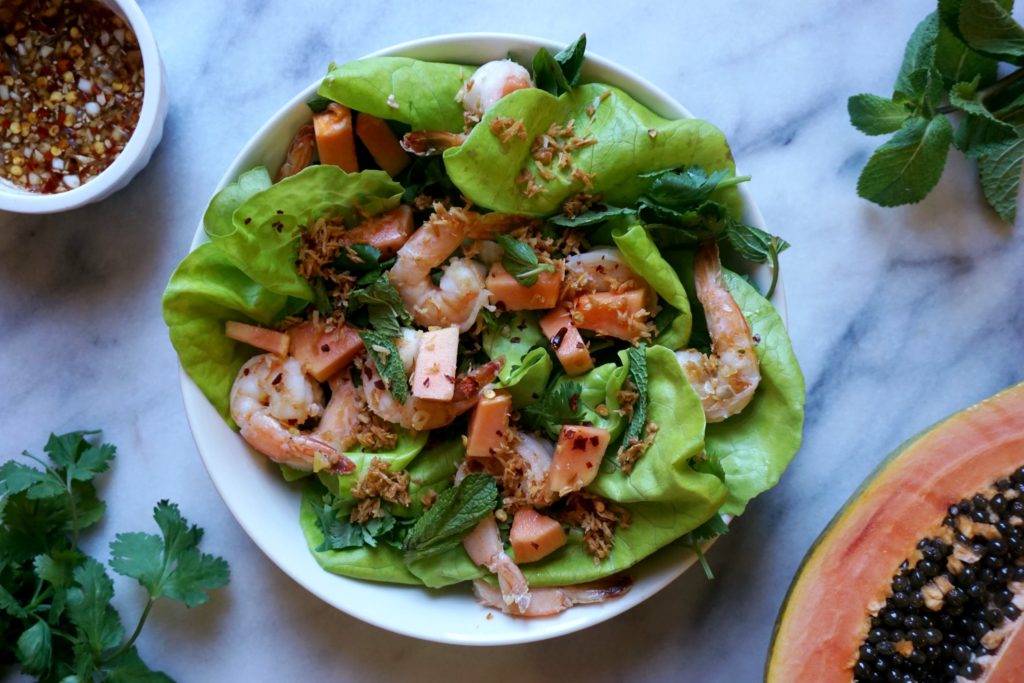One of the most nutritious and delicious fruits available, the Papaya is native to the Caribbean and Southeast Asia. Papayas are found in most governments’ dietary guidelines, and are also claimed to be the most nutritious fruit in the world.
For the last few years, papaya has become a popular fruit in the US. It has been featured on many popular TV shows and movies that need it as a food source, and even many nutritional products have papaya as an ingredient. Papaya is not only a good source of dietary fiber, but also vitamins A and C, and potassium. It is also rich in antioxidants known as carotenoids which are known to protect against heart disease, cancer, and age-related eye conditions. Additionally, papaya contains an enzyme called papain, which is used to tenderize meat and other proteins and is also used in treating wounds.
Papaya is one of the most versatile fruits, as it can be used in a variety of ways to enhance your cooking. It is a tropical fruit that can be eaten fresh, canned, dried, and frozen. It has a sweet flavor that is not as strong as that of mango, and is a good source of vitamin A, thiamine, niacin, magnesium iron, and potassium. It is also a good source of riboflavin, calcium, and lycopene. This fruit is widely consumed in many Asian countries, and is used to make many different dishes.
A Quick Look
The tropics’ papaya, often known as “pawpaw,” is a sunset-colored, abundantly juicy, lusciously sweet, and slightly musky fruit that thrives in warm temperatures. The high carotenoid content of papaya gives it a glowing orange color. Furthermore, papaya is a good source of vitamin C. Papaya is unique in that it includes another health-promoting component called papain, an enzyme with both digestive and anti-inflammatory effects. Papaya seeds are edible and have a pleasant peppery flavor, despite the fact that they are usually thrown. A ripe papaya is difficult to resist, but it is also simple to eat and may be demolished swiftly with an eager spoon. Add a squeeze of fresh lime to your culinary experience, and the rest is history.
Overview
The papaya, also known as “pawpaw,” is a tropical fruit that is synonymous with hot weather. Papaya is a tropical delight that is sunset-colored, abundantly juicy, and lusciously aromatic and sweet.
Papaya is rich in nutrients and, more importantly, in a chemical called papain, which is specific to papaya. Although papain is present in ripe papayas, it is found in the flesh of immature green papayas in the greatest concentrations.
Papaya plants are unique in that they have three distinct sexes: male, female, and hermaphrodite. Pollen is produced by male plants, while no fruit is produced by female plants. Female plants may produce edible fruits if pollinated, but only if they are pollinated. Hermaphrodite plants have both pollinating and fruit-producing sections on the same flower, allowing them to self-pollinate and produce delicious fruits without the need to locate a partner.
Because papaya plants are frost-sensitive, they can only be grown in consistently warm climates. Papayas are believed to have originated in Mexico, and the nation remains one of the top producers of the fruit in the world, behind only India, Brazil, and Indonesia.
Identification
Papayas are pear-shaped and have a yellowish-orange skin speckled with green flecks when fully mature.
Papayas are soft and buttery on the inside, with a glowing orange color and a sweet, juicy, musky taste. A hole in the fruit’s core is packed with black, gelatinous seeds. Despite the fact that these seeds are usually thrown away, they are theoretically edible. Because they have a similar bite to pepper, these seeds are sometimes dried and used as a replacement.
Although ripe papayas are preferred, unripe green papayas are also eaten. On the exterior, an unripe papaya will be nearly completely green, with firm, sour, and crunchy meat on the interior. It’s excellent shredded into savory meals like the famous Southeast Asian green papaya salad in this state.
Nutritional Information
A cup of ripe, raw, cubed papaya (about 140g) has 55 calories, 1.0 gram of protein, 14.0 gram of carbs, 3.0 gram of fiber, 8.0 gram of sugar, and no fat. Papaya is a rich source of folate and a good source of vitamin C and vitamin A (in the form of beta carotene).
Selection
Year-round, papayas may be found as imports at most major supermarket shops.
If you want to consume your papaya right away, look for examples that are hefty, somewhat mushy, and have a reddish orange skin. Large green or yellow patches on the papaya may indicate that it needs a few more days to mature.
A few nicks, bruises, and black patches are to be expected due to the softness of the skin. The papaya is beyond its prime if it is excessively soft and mushy, has significant regions of bruising, or exhibits any indications of mold.
Storage
A completely ripe papaya should be refrigerated and eaten within two days after purchase. Alternatively, it may be sliced into pieces (removing the skin and seeds) and frozen for up to six months in an airtight container.
If you’ve bought an underripe papaya and want to speed up the ripening process, put it in a paper bag with a banana and keep it at room temperature to develop.
Preparation
Papayas need very little preparation before being consumed.
Cutting a papaya in half lengthwise and scooping out the seeds is the simplest method to eat it. Then, using a spoon, eat the papaya scoop by scoop until the skin is scraped off, which may be discarded.
Quick cooking tip: Squeeze a little of fresh lime juice on your papaya to enhance the flavor. Lime and papaya go along.
SALAD WITH COCONUT SHRIMP AND PAPAYA WITH CHILI LIME DRESSING
The sweet, juicy papaya gets a spicy makeover! With juicy papaya, succulent shrimp, toasted coconut, fresh herbs, and a little spicy, acidic vinaigrette, this light dinner packs a punch.
Ingredients
Lime juice as a dressing 1 tablespoon of fish sauce 4 teaspoons honey 2 tsp fresh ginger root, coarsely minced 1 tsp finely minced garlic 1 red chili flakes clove a quarter teaspoon Salad dressing: coconut oil 2 tsp unsweetened, dry, shredded coconut a quarter cup of coconut oil 2 tsp fresh ginger root, coarsely minced 1 tsp finely minced garlic 1 red chili flakes clove a pinch of salt uncooked, thawed 1/4 teaspoon shrimp 8 oz. ripe papaya, cut into cubes 1 cup butter lettuce (also known as boston lettuce) 3 cups finely chopped cilantro 1/2 cup roughly chopped mint leaves 1/2 cup
Directions
15-minute prep time Time to prepare: 5 minutes 2 servings (about)
Dressing Ingredients:
Whisk together all of the ingredients in a jar until the honey is completely dissolved. Remove from the equation.
Salad Ingredients:
To begin, roast the shredded coconut in a pan with coconut oil and shredded coconut over medium heat until golden brown and aromatic. This will take just 1-2 minutes, and the coconut should be continuously stirred to avoid scorching. Place the coconut shreds in a separate dish to cool after they’ve been roasted.
Then, in a pan over medium-high heat, sauté the coconut oil, ginger, garlic, red chili flakes, and salt until fragrant, approximately 1-2 minutes. Add the shrimp and simmer for 5 minutes, or until they lose their translucency, become orange, and curl into a C shape. Remove the pan from the heat and put it aside.
Divide the papaya, lettuce, cilantro, and mint into two dishes to make the salads. Toss the salad with the shrimp, toasted coconut, and dressing. Serve right away and enjoy.
Book of Free Recipes
Every month, the Encyclopedia of Food grows as we include new delicacies and stunning food photography. Simply click this link to keep up with the latest news. Following that, we’ll give you a complimentary copy of our recipe book. We’ll also notify you when we introduce new and tasty items to the site.
For a free copy of the Encyclopedia of Food recipe book, go here.
Foods That Are Related
Papaya is a tropical fruit that is widely grown in Central America and the Caribbean. The fruit’s name comes from its resemblance to a pawpaw, which is also a tropical fruit.. Read more about green papaya recipes and let us know what you think.
Papaya is not bad for you, but it can be if you eat too much of it. It contains a substance called papain that can cause digestive problems and diarrhea in some people."}},{"@type":"Question","name":"What is the best way to eat a papaya?","acceptedAnswer":{"@type":"Answer","text":" The best way to eat a papaya is by cutting it in half and then peeling the skin off."}}]}
Frequently Asked Questions
What can you do with fresh papaya?
Fresh papaya is a fruit that has a high content of vitamin C and fiber. It can be eaten raw or cooked, and it is often used in salads.
Why is papaya bad for you?
Papaya is not bad for you, but it can be if you eat too much of it. It contains a substance called papain that can cause digestive problems and diarrhea in some people.
What is the best way to eat a papaya?
The best way to eat a papaya is by cutting it in half and then peeling the skin off.
Related Tags
This article broadly covered the following related topics:
- papaya nutrition
- papaya fruit
- papaya
- papaya fruit benefits
- papaya nutrition facts




